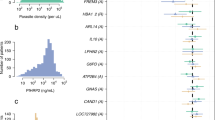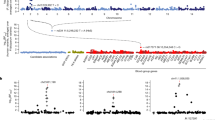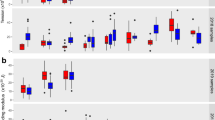Abstract
THE α+-thalassaemias are the commonest known human genetic disorders, affecting up to 80 per cent of some populations1. Although there is good evidence from both epidemiological2,3 and clinical4 studies that these gene frequencies reflect selection by, and protection from, malaria, the mechanism is unknown. We have studied the epidemiology of malaria in childhood on the southwestern Pacific island of Espiritu Santo in Vanuatu and here we report that, paradoxically, both the incidence of uncomplicated malaria and the prevalence of splenomegaly, an index of malaria infection, are significantly higher in young children with α+-thalassaemia than in normal children. Furthermore, this effect is most marked in the youngest children and for the non-lethal parasite Plasmodium vivax. The α+-thalassaemias may have been selected for their ability beneficially to increase susceptibility to P. vivax, which, by acting as a natural vaccine in this community, induces limited cross-species protection against subsequent severe P. falciparum malaria.
This is a preview of subscription content, access via your institution
Access options
Subscribe to this journal
Receive 51 print issues and online access
$199.00 per year
only $3.90 per issue
Buy this article
- Purchase on SpringerLink
- Instant access to full article PDF
Prices may be subject to local taxes which are calculated during checkout
Similar content being viewed by others
References
Weatherall, D. J. Ann. Trop. Med. Parasitol. 81, 539–548 (1987).
Flint, J. et al. Nature 321, 744–750 (1986).
Flint, J., Harding, R. M., Boyce, A. J. & Clegg, J. B. Bailliere's Clin. Haematol. 6, 215–262 (1993).
Yates, S. N. R. thesis, Univ. Oxford (1995).
Higgs, D. R. et al. Blood 73, 1081–1104 (1989).
Maitland, K. et al. Trans. R. Soc. Trop. Med. Hyg. (in the press).
Oppenheimer, S. J. et al. Trans. R. Soc. Trop. Med. Hyg. 81, 322–326 (1987).
Luzzi, G. A., Torri, M., Aikawa, M. & Pasvol, G. Br. J. Haematol. 74, 519–524 (1990).
Weatherall, D. J. & Clegg, J. B. The Thalassaemia Syndromes 212–213 (Blackwell, Oxford, 1981).
Pasvol, G., Weatherall, D. J. & Wilson, R. J. M. Br. J. Haematol. 45, 285–295 (1980).
Pasvol, G., Weatherall, D. J. & Wilson, R. J. M. Nature 270, 171–173 (1977).
Luzzi, G. A. et al. J. Exp. Med. 173, 785–791 (1991).
Balfour, M. C. Am. J. Trop. Med. 15, 301–329 (1935).
Earle, W. C. Puerto Rico J. Public Hyg. Trop. Med. 15, 3–27 (1939).
Djaparadse, P. Med. Parasitol. Parasite Dis. (Moscow) 11, 3–11 (1942).
Gunewardena, D. M., Carter, R. & Mendis, K. N. Mem. Inst. Oswaldo Cruz 89, 61–63 (1994).
Bate, C. A. et al. Infect. Immun. 60, 1241–1243 (1992).
Hill, A. V. S. Bailliere's Clin. Haematol. 5, 209–238 (1992).
Allen, S. J. et al. Trans. R. Soc. Trop. Med. Hyg. 87, 282–285 (1993).
Bowden, D. K., Hill, A. V. S., Higgs, D. R., Weatherall, D. J. & Clegg, J. B. Lancet ii, 1025–1028 (1985).
Ganczakowski, M. et al. Br. J. Haematol. 89, 485–495 (1995).
Hill, A. V. S. et al. Nature 352, 595–600 (1991).
Genton, B. et al. Nature 378, 564–565 (1995).
Willcox, M., Bjorkman, A. & Brohult, J. Ann. Trop. Med. Parasitol. 77, 335–347 (1983).
Ruwende, C. et al. Nature 376, 246–249 (1995).
Old, J. M. & Higgs, D. R. in Methods in Haematology (ed. Weatherall, D. J.) 74–102 (Churchill Livingstone, Edinburgh, 1983).
Gilles, H. M. in Essential Malariology (eds Gilles, H. M. & Warrell, D. A.) 134 (Arnold, London, 1993).
Author information
Authors and Affiliations
Rights and permissions
About this article
Cite this article
Williams, T., Maitland, K., Bennett, S. et al. High incidence of malaria in α-thalassaemic children. Nature 383, 522–525 (1996). https://doi.org/10.1038/383522a0
Received:
Accepted:
Issue Date:
DOI: https://doi.org/10.1038/383522a0



